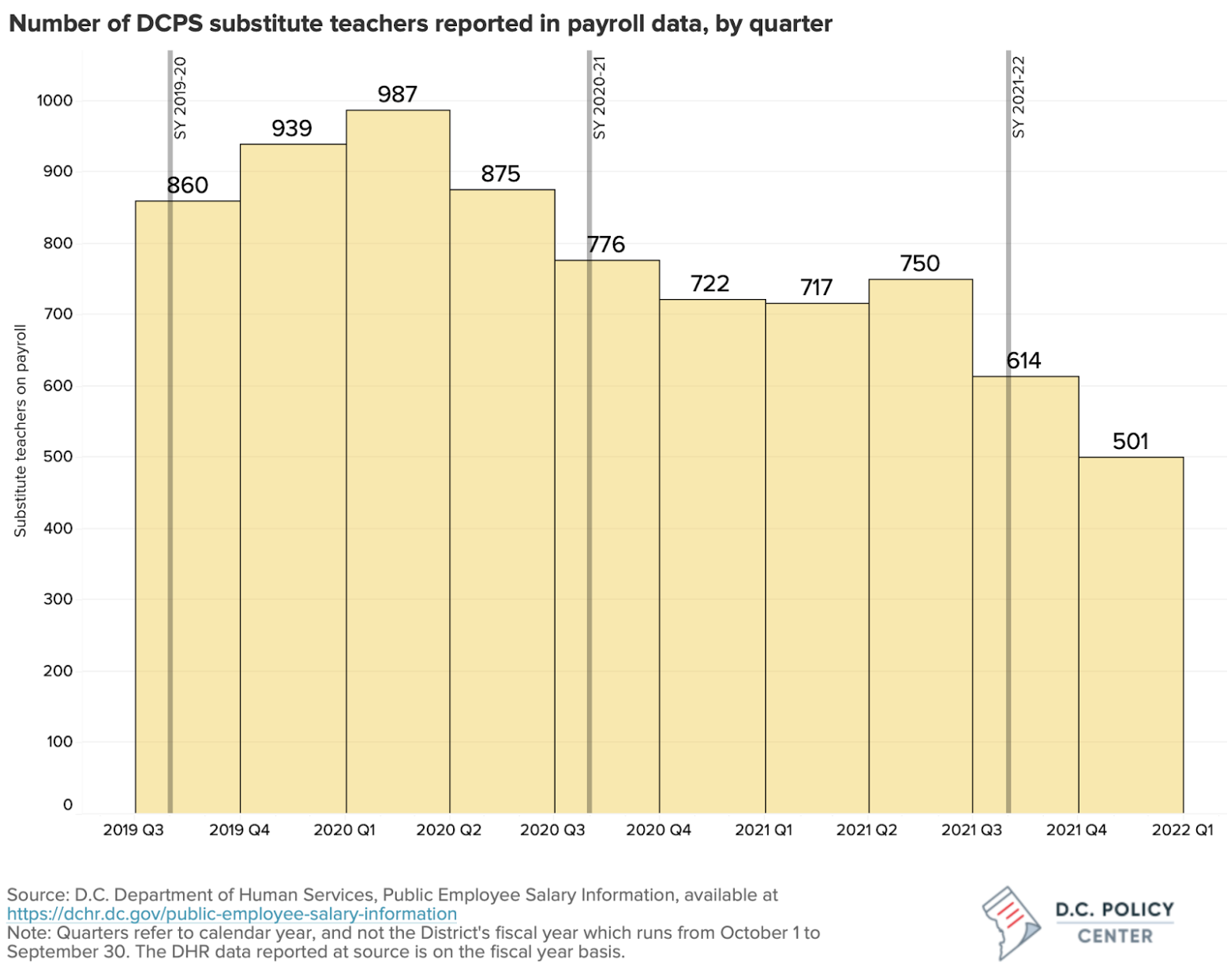The nationwide substitute teacher shortage has had wide-reaching effects on the education system. When a school district does not have enough substitute teachers to meet staffing needs when teachers take time off (or use their sick days), the work often gets passed to other teachers in the school who have to give up their planning period and personal time to cover these absences. In a survey conducted by the National Education Association, nearly 55 percent of its teachers were considering quitting due to burnout, with many citing substitute shortages as a contributing factor.
D.C. has not escaped the national substitute shortage facing districts across the country. According to public salary data published by District of Columbia Public Schools (DCPS), the number of substitute teachers on the payroll has dropped from a peak of 987 in the first quarter of 2020, to 501 in the first quarter of 2022 (data are not available for public charter schools). While enrollment has shrunk in DCPS schools by four percent since 2019, the decrease in substitutes has outpaced that.
When schools cannot find substitutes to cover teacher absences, teachers and staff fill the gap, according to research from the Brookings Institution. When absences weren’t covered in a large urban district before the pandemic, findings show that:
- Students were put into another teacher’s classroom (37 percent of the time),
- Teachers had to use their planning period (35 percent of the time),
- Administrative staff covered the class (12 percent of the time), or
- Other staff members such as aides covered the class (16 percent of the time).
This takes staff away from critical roles, overloads teachers’ classrooms, and deprives teachers of the ability to plan lessons, grade papers, contact parents or do other key roles during the school day.
Even when substitute teachers are available, they are often not equally distributed among schools. While teachers take off around the same number of school days each year regardless of the characteristics of the school they teach in, schools with higher percentages of Black and Hispanic students, schools with large shares of students from low-income census tracts, and schools with lower achievement scores face far more difficulty in recruiting substitutes. Forty-nine percent of teachers working in schools with high percentages of Black and Hispanic students reported difficulty finding substitutes, compared to only 9 percent of teachers working in schools with the lowest number of Black and Hispanic students.
Nationally, many districts are lowering educational and experience requirements for substitute teachers to fill staffing gaps. They are choosing to focus not on credentials, but on having someone in the room. For instance, in some Illinois school districts, anyone with an Associate’s degree who has completed a one-day course can substitute. In Kansas, any 18 year-old with a high school diploma can serve as a substitute teacher. Many districts have asked parents or even the National Guard to fill in.
However, research from the Massachusetts Institute of Technology suggests having short-term, uncredentialed substitute teachers for long periods of time can greatly lower student learning outcomes in reading and math, while longer-term credentialed teachers can lower potential student learning loss. Most teachers are absent somewhere around 5 to 10 percent of the school year. Putting in substitute teachers who may not have the necessary skills to effectively lead and teach a classroom could result in major student learning loss.
Issues surrounding hiring substitutes in D.C.
Many substitute teachers may choose not to join DCPS due to relatively low pay (a nationwide problem). While substitute pay was recently raised to $160 per day, or $20 per hour, it still remains below the $23.13 the Massachusetts Institute of Technology estimates someone needs to comfortably live in D.C.
Substitutes may choose to work in other areas with higher-paying jobs. However, nearby districts like Arlington Public Schools and Montgomery County Public Schools offer lower pay to substitutes despite similar living costs. DCPS currently has one of the highest daily pay rates for substitutes in the D.C. metropolitan region.
DCPS substitutes, unlike in other districts, are eligible for some benefits. According to DCPS, they can accrue some sick and safe leave,1 though far less than full-time teachers in the District. They are also eligible to enroll in health insurance (HMO only) once they have completed 90 days of work in a 12 month period. Increasing benefits and pay may help attract more substitutes to the District.
